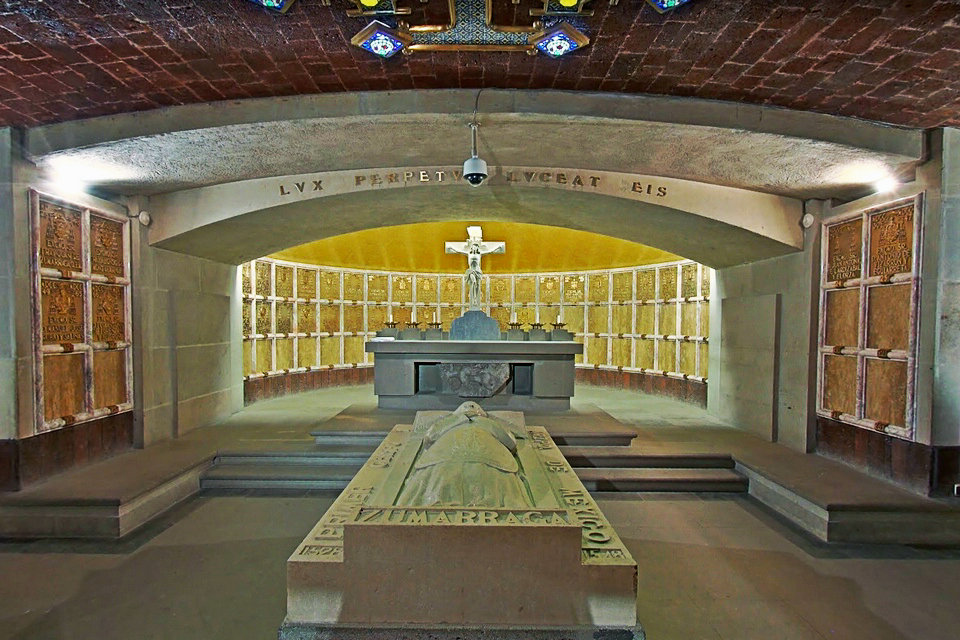Crypt of the Archbishops, Mexico City Metropolitan Cathedral


The Crypt of the Archbishops is located below the floor of the cathedral beneath the Altar of the Kings. The entrance to the crypt from the cathedral is guarded by a large wooden door behind which descends a winding yellow staircase. Just past the inner entrance is a Mexica-style stone skull. It was incorporated as an offering into the base of a cenotaph to Juan de Zumárraga, the first archbishop of Mexico. Zumárraga was considered to be a benefactor of the Indians, protecting them against the abuses of their Spanish overlords. There is also a natural-sized sculpture of the archbishop atop the cenotaph.
The entrance is made through a large wooden door behind which, a spiral staircase that gives access to the crypt, made by the architect Ernesto Gómez Gallardo Argüelles , descends . In the center is a cenotaphwith a life-size sculpture of Zumárraga, whose base is a skull carved in stone in Aztec style, since it was considered protector of the Indians against the abuses of their masters. Behind this, there is an altar with another pre-Hispanic geometric sculpture located at the bottom. The other archbishops are in niches in the walls, indicated by bronze plates in which the name and the episcopal shield of each one appear. On the floor are marble slabs that cover the niches of other people buried in the crypt.
On its walls are dozens of bronze plaques that indicate the locations of the remains of most of Mexico City’s former archbishops, including Cardinal Ernesto Corripio y Ahumada. The floor is covered with small marble slabs covering niches containing the remains of other people.
The cathedral contains other crypts and niches where other religious figures are buried, even in the chapels. In addition, it has crypts for the faithful who wish to be buried in the cathedral.
Mexico City Metropolitan Cathedral
The Metropolitan Cathedral of the Assumption of the Most Blessed Virgin Mary into Heavens (Spanish: Catedral Metropolitana de la Asunción de la Santísima Virgen María a los cielos) is the seat of the Catholic Archdiocese of Mexico. It is situated atop the former Aztec sacred precinct near the Templo Mayor on the northern side of the Plaza de la Constitución (Zócalo) in Downtown Mexico City. The cathedral was built in sections from 1573 to 1813 around the original church that was constructed soon after the Spanish conquest of Tenochtitlan, eventually replacing it entirely. Spanish architect Claudio de Arciniega planned the construction, drawing inspiration from Gothic cathedrals in Spain.
Due to the long time it took to build it, just under 250 years, virtually all the main architects, painters, sculptors, gilding masters and other plastic artists of the viceroyalty worked at some point in the construction of the enclosure. This same condition, that of its extensive period of construction, allowed the integration into it of the various architectural styles that were in force and in vogue in those centuries: Gothic, Baroque, Churrigueresque, Neoclassical, among others. Same situation experienced different ornaments, paintings, sculptures and furniture in the interior.
Its realization meant a point of social cohesion, because it involved the same ecclesiastical authorities, government authorities, different religious brotherhoods as many generations of social groups of all classes.
It is also, as a consequence of the influence of the Catholic Church on public life, that the building was intertwined with events of historical significance for the societies of New Spain and independent Mexico. To mention a few, there are the coronation of Agustín de Iturbide and Ana María Huarte as emperors of Mexico by the President of the Congress; the preservation of the funeral remains of the aforementioned monarch; burial until 1925 of several of the independence heroes such as Miguel Hidalgo y Costilla and José María Morelos; the disputes between liberals and conservatives caused by the separation of the church and the state in the Reform; the closure of the building in the days of the Cristero War; the celebrations of the bicentennial of independence, among others.
The cathedral faces south. The approximate measurements of this church are 59 metres (194 ft) wide by 128 metres (420 ft) long and a height of 67 metres (220 ft) to the tip of the towers. It consists of two bell towers, a central dome, three main portals. It has four façades which contain portals flanked with columns and statues. It has five naves consisting of 51 vaults, 74 arches and 40 columns. The two bell towers contain a total of 25 bells.
The tabernacle, adjacent to the cathedral, contains the baptistery and serves to register the parishioners. There are five large, ornate altars, a sacristy, a choir, a choir area, a corridor and a capitulary room. Fourteen of the cathedral’s sixteen chapels are open to the public. Each chapel is dedicated to a different saint or saints, and each was sponsored by a religious guild. The chapels contain ornate altars, altarpieces, retablos, paintings, furniture and sculptures. The cathedral is home to two of the largest 18th-century organs in the Americas. There is a crypt underneath the cathedral that holds the remains of many former archbishops. The cathedral has approximately 150 windows.
Over the centuries, the cathedral has suffered damage. A fire in 1967 destroyed a significant part of the cathedral’s interior. The restoration work that followed uncovered a number of important documents and artwork that had previously been hidden. Although a solid foundation was built for the cathedral, the soft clay soil it is built on has been a threat to its structural integrity. Dropping water tables and accelerated sinking caused the structure to be added to the World Monuments Fund list of the 100 Most Endangered Sites. Restoration work beginning in the 1990s stabilized the cathedral and it was removed from the endangered list in 2000.